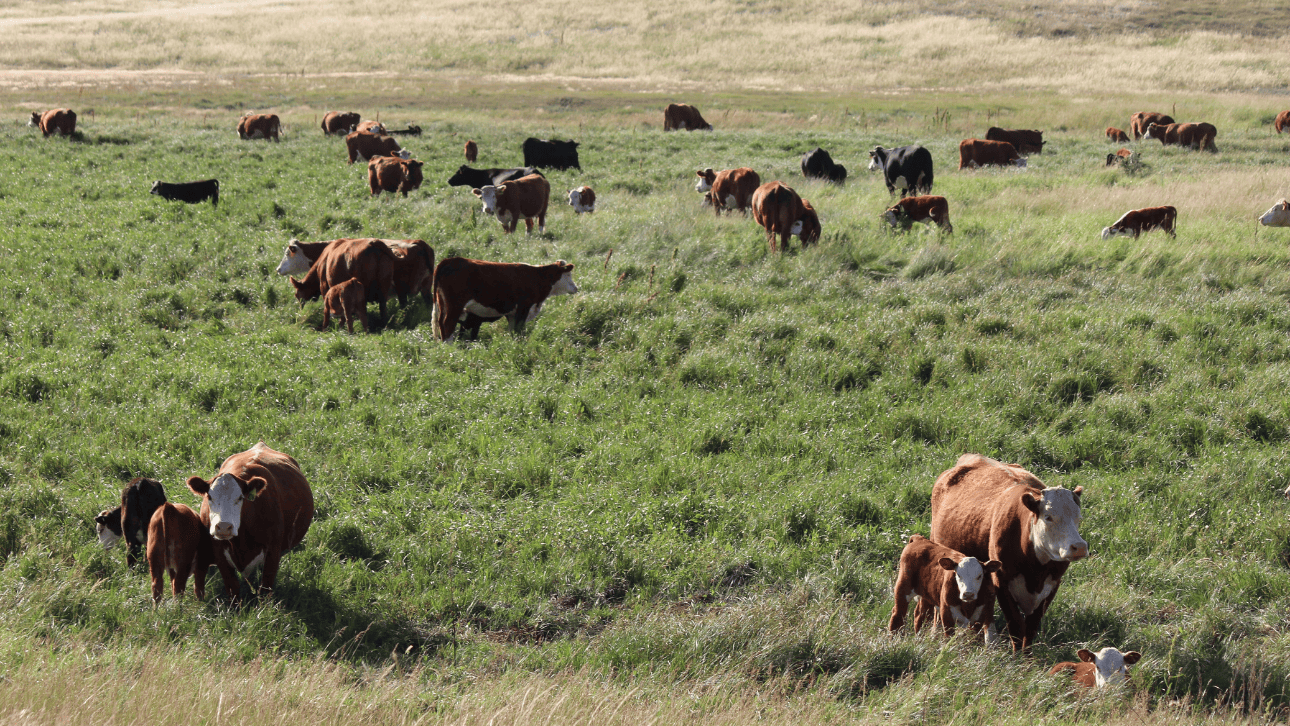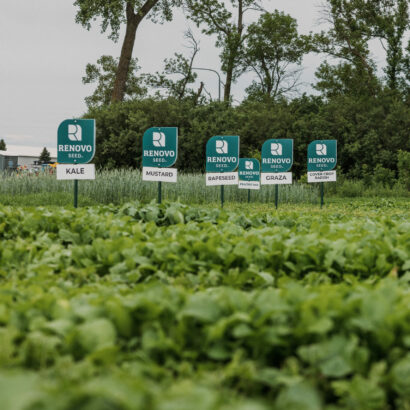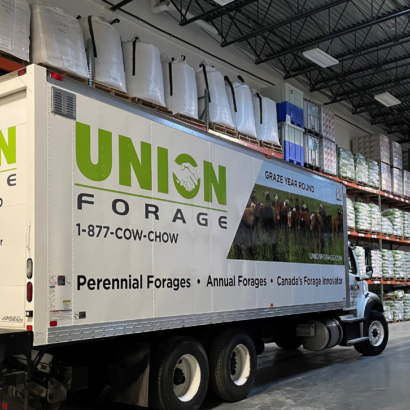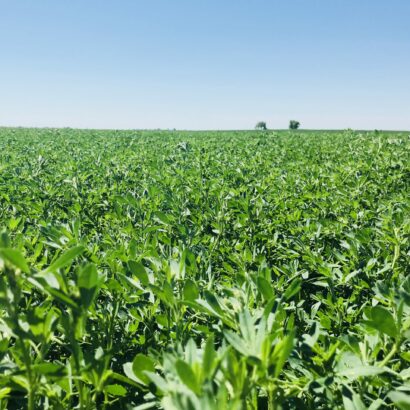Gemstone Cattle Company herd grazing on a perennial pasture mix. Photo courtesy of Gemstone Cattle Company.
FOR IMMEDIATE RELEASE: April 14, 2025
Contact: Laura Vsetecka, laurav@renovoseed.com
(CALGARY, AB, April 14, 2025) – A family of Alberta crop and beef farmers credit their exquisite beef flavour, herd health, and soil health to diverse forage mixes, saying the compounding benefits are more than what shows up on a feed test.
Daniel, Lorin, and Barry Doerksen operate Gemstone Cattle Company and Gemstone Grass Fed Beef near Gem, Alberta about 90 miles east of Calgary.
“We operate a commercial cow-calf herd that’s predominantly Hereford and Angus base, and we also sell breeding bulls. They are 100% forage developed. We had the genetics before we started doing the grass fed side of our business, which we feel was a big advantage to us. We have a more moderate cow size that puts on fat really easy, and it’s just been huge for our program. A big part of it is when you have bulls you know can get fat on grass with low inputs, that’s going to transpire into what their calves can do, too,” shared Daniel.
When asked how they’re coordinating their crop plan with forage plans for the beef, Lorin says that rotational grazing and creating a diverse forage chain are key components of their operation.
“We try to establish a forage chain. What that means is by late May or early June, we have our cattle grazing on perennial grass, and we will seed some acres of annual cover crop each year specifically for grazing. So, we’re selecting cover crops that work well for grazing. And we practice rotational grazing through our perennial pastures, and then onto the annuals, and then back to the perennials.”
“We’ve also switched almost exclusively to polycrop silage. We still do use some straight barley and ryegrass silage, but we’ve really found a benefit of using polycrops. That includes anywhere from eight to 16 different species of crops that are seeded in the spring, and we wait for them to get quite mature before harvest – we harvest in the middle to end of August. We also try to put some species in there that will grow back for some fall grazing, which has really helped extend our grazing,” Lorin explained.
“We found that the polycrops are creating a much higher quality, balanced silage. And getting enough energy and protein in the diet to maintain anywhere from two to three pounds of gain a day is what we forecast,” he continued.
Justin Fruechte, Product Expert for Renovo Seed, agreed that a diverse forage mix not only widens the nutritional plane, but also has stacked benefits for the livestock and the soil.
“Once you start feeding these polycrops with eight, 10, or 12 different species in there, there are so many added benefits. More than just the regrowth for grazing later, but the opportunity to lower different mineral additions into your TMR and things like that. The amount of calcium that you can get by adding brassicas into your blend and the amount of vitamin E that you see. And it’s not just for the livestock, but definitely for the soil too,” Fruechte shared.
Lorin elaborated that even if the compounding benefits don’t show up on a feed test, they see them in the quality of the beef product they produce.
“Sometimes our feed tests don’t look much different than a monocrop, but it’s just the sheer variety – the different types of proteins and amino acids that are in the feed all provide benefits to the animal. Another reason we’re doing this for flavour, we know that the more diversity of plants that an animal consumes, the more potential there is to get a great flavour profile in the beef. We’ve seen that too, the feedback from our customers is great. It just seems like a win-win,” he said.
But the positive reviews extend past more than just the quality beef. Daniel Doerksen says their breeding customers are also impressed with the health of their bulls through the breeding season.
“I get lots of feedback from customers really impressed with how the bulls hold their condition right through the breeding season. People are definitely buying in to what we’re doing. And we have lots of cattle that go into the conventional grain fed operation too, and they feed really well there as well. So we’ve seen it on both sides.”
Planning for upcoming planting
When Fruechte asked the Doerksens about their plans for the upcoming planting season, it was clear that a full-system approach for soil and livestock health is top of mind.
“It starts with soil sampling. We like to sample every spring and get an idea of what nutrient requirements we need. We have found that since using cover crops, we’ve been able to back down on our fertilizers over time, which has been a real benefit. We’re selecting a mix of grazing crops and silage for winter feed,” Lorin shared.
Daniel elaborated that their management plans focus on low soil disturbance and working with Mother Nature to control weed pressure.
“We try to manage when we seed, maybe seeding a little bit later especially on the warm season plants, and also have plants that grow quite vigorously to out-compete the weeds. And we’ve gone to a no-till drill with very minimal soil disturbance, because lower disturbance in the soil definitely reduces the amount of weed pressure that we see in the crop. We started adding some winter triticale in our mixes, too. That’s new for us this year, we’ll see if it helps with some weed control in the spring. We also do a burn down before we plant to make sure we’re really weed-free,” he explained.
Developing diverse seed mixes for forage and soil health
Daniel and Lorin shared that they will stick to predominantly cool-season species for May planting, and elaborated that Italian Ryegrass is a key component of their mixes.
“We’re using predominantly cool-season, we just find that it is working better. The cereals we’re using are oats and spring triticale, but mostly cool-season with the addition of some sunflower and a bit of sorghum. We find Italian ryegrass works well. We seed that at a fairly high rate, even up to eight pounds in the blend. It really shows up in the fall after the silage crop. We’ve also started adding a lot of forbs, so plantain and chicory and also phacelia has been a new one. Phacelia doesn’t necessarily have a lot of grazing quality, but we think it’s adding a lot of quality to the soil and improving the soil over time,” shared Lorin.
Fruechte agreed that mixing in plants like phacelia or flax adds soil benefits, while not taking away from tonnage.
“When we develop these forage mixes, my first priority is forage, tonnage, quality, and diversity. But along with that diversity, if we can improve some soil by throwing in just a little bit of this and that, I don’t really think you’re giving up tonnage by doing that,” he shared.
The Doerksens will follow up by planting a warm-season blend later in the summer.
“We’ve found that in our environment, the warm-season plants do a lot better if they’re seeded late June, even early July. We do have a warm-season blend this year we’re putting in. We’ll take a first cut of hay off of an old hay crop, and then we’re going to spray it out and seed a fall grazing crop that is predominantly warm-season species,” Lorin explained.
Find the Doerksen family and products online
Learn more about the cattle side of the Doerksen operation online at www.gemstonecattle.com. Gemstone Grass fed beef is available for shipping in all of Alberta. Find their products at www.gemstonegrassfedbeef.com. Or, Lorin invites you to visit them in person at the Calgary Farmers Market West.
“If you’re ever in Calgary, definitely check out the Calgary Farmers Market West. We have little butcher shop in there and a kitchen where we’re serving smash burgers and gourmet sandwiches. It’s a fun place to visit,” Lorin said.
###
About Renovo Seed
Renovo Seed leads the seed industry as a visionary in positive land use solutions. Backed by Millborn’s powerful supply chain, Renovo Seed works to improve the resiliency of the land for generations to come with a robust seed lineup and unmatched team of experts who design practical, tailored solutions for farmers, ranchers, and landowners. For more information, visit RenovoSeed.ca.
About Gemstone Cattle Company and Gemstone Grass Fed Beef
Gemstone Cattle Company and Gemstone Grass Fed Beef are extensions of Doerksen Farms, a multi-generation mixed farm near Gem, Alberta. Gemstone Cattle Company raises commercial and registered Hereford and Angus cattle pastured on dry and irrigated pasture. Learn more at GemstoneCattle.com. Gemstone Grass Fed Beef produces high quality grass finished beef that is tender, nutrient-dense, well marbled, and flavourful for a unique local eating experience. Learn more at GemstoneGrassFedBeef.com.




Discussion
0 Comments